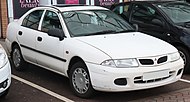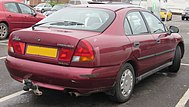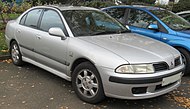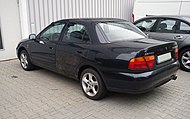Mitsubishi Carisma
| Mitsubishi Carisma | |
|---|---|
 | |
| Overview | |
| Manufacturer | Mitsubishi |
| Production | 1995–2004 |
| Assembly | Born, Netherlands (NedCar) |
| Designer | Kiyoshi Honda |
| Body and chassis | |
| Class | Large family car |
| Body style | 5-door hatchback 4-door saloon |
| Layout | FF Layout F4 layout |
| Related | Mitsubishi Space Star Volvo S40 Proton Waja |
| Powertrain | |
| Engine | 1.3 L 4G13 I4 1.6 L 4G92 I4 (DA1) 1.8 L 4G93 I4 (DA2) 1.8 L 4G93 GDI I4 1.9 L F8Q TD I4 1.9 L F9Q DI-D I4 |
| Transmission | 5-speed manual 4-speed auto |
| Dimensions | |
| Wheelbase | 2,550 mm (100.4 in) |
| Length | 4,450 mm (175.2 in) |
| Width | 1,695 mm (66.7 in) |
| Height | 1,405 mm (55.3 in) |
| Kerb weight | 1,105–1,180 kg (2,436–2,601 lb) |
| Chronology | |
| Predecessor | Mitsubishi Lancer hatchback (Europe) |
| Successor | Mitsubishi Lancer (Europe) |
This article contains wording that promotes the subject in a subjective manner without imparting real information. (January 2021) |
The Mitsubishi Carisma is a large family car produced for the European market by Mitsubishi from 1995 to 2004.[1]
The model name was derived from a combination of the English car and the Greek kharisma, meaning "divine gift".[2] It was co-developed with Volvo, sharing its chassis with the first generation of the Volvo S40, and built at the NedCar factory in Born, Netherlands, which the two companies co owned at the time. Over 350,000 were built during its production run. Volume production begun in May 1995 with sales starting in Holland in June. The four-door saloon sales started the following year.[3][4][5][6]
Development[]
Available as a four door saloon or a five door hatchback style only, it featured inline four gasoline engines from 1.3 L (introduced later in life) to 1.8 L, 1.8 L gasoline direct injection engine from 1998, and 90 hp (67 kW) 1.9 L turbodiesel powerplants sourced from Renault, later with the 100 hp (75 kW) 1.9 DI-D common rail diesel[clarification needed] engine, the same as used in both Volvo and Renault cars. Mitsubishi claimed the 1.8 GDI engine offered a 20% saving in fuel consumption, 10% increase in power and 20% decrease in greenhouse gases when compared to a conventional 1.8 petrol engine.[7]

The Carisma had a fairly neutral design as a result of being Mitsubishi's first attempt to target the traditionally conservative European company car market, where it competed with the likes of the Ford Mondeo.[8]
The Carisma was facelifted in 1999, with the new models being launched in the UK on the 1st of August. This included a new front end, interior, boot lid and rear lights. It also featured ABS as standard, a wider front track and uprated suspension. The car underwent a very light redesign again in 2002, with the main difference being new tinted headlights, new alloy wheel designs and black front grilles, instead of chrome. The car was placed between the Lancer and the Galant, although after production ended in December 2004, the Lancer took its place in Mitsubishi's European range.
In several markets where the Lancer was not available, the Evolution version was rebadged as the Mitsubishi Carisma GT. In Japan, the Carisma was sold at a specific retail chain called Car Plaza. It was only available for 1996 and 1997 as a 1.8 saloon, with trim levels being L, LX and LS. The chassis was also used by Proton to develop the Proton Waja.
Production and sales[]
| Year | Production | Sales |
|---|---|---|
| 1995 | 19,100 | ? |
| 1996 | 44,401 | ? |
| 1997 | 82,255 | ? |
| 1998 | 78,239 | ? |
| 1999 | 54,460 | ? |
| 2000 | 29,800 | 38,548 |
| 2001 | 22,203 | 28,647 |
| 2002 | 28,776 | 30,429 |
| 2003 | 26,074 | 28,123 |
| 2004 | – | 9,875 |
(Sources: Fact & Figures 2000, Fact & Figures 2005, Mitsubishi Motors website)
Gallery[]

Carisma (1995–1999)

Carisma (1995–1999)

Carisma (1999–2002)
Carisma (1999–2002)

Carisma (2002–2004)

Carisma (2002–2004)

Mitsubishi Carisma 1997 (Saloon)
Engines[]
| Model | Engine | Displacement | Valvetrain | Fuel system | Max. power at rpm | Max. torque at rpm | Years |
|---|---|---|---|---|---|---|---|
| Petrol engines | |||||||
| 1.3 | Mitsubishi 4G13 | 1299 cc | SOHC 16v | Multi-point fuel injection | 60 kW (82 PS; 80 bhp) at 5000 rpm | 120 N⋅m (89 ft⋅lbf) at 4000 rpm | 2001–2004 |
| 1.6 | Mitsubishi 4G92 | 1597 cc | SOHC 16v | Multi-point fuel injection | 66 kW (90 PS; 89 bhp) at 5500 rpm | 137 N⋅m (101 ft⋅lbf) at 4000 rpm | 1995–1997 |
| 1.6 | Mitsubishi 4G92 | 1597 cc | SOHC 16v | Multi-point fuel injection | 73 kW (99 PS; 98 bhp) at 5750 rpm | 137 N⋅m (101 ft⋅lbf) at 4000 rpm | 1997–2000 |
| 1.6 | Mitsubishi 4G92 | 1597 cc | SOHC 16v | Multi-point fuel injection | 76 kW (103 PS; 102 bhp) at 6000 rpm | 141 N⋅m (104 ft⋅lbf) at 4500 rpm | 2000–2004 |
| 1.8 | Mitsubishi 4G93 | 1834 cc | SOHC 16v | Multi-point fuel injection | 85 kW (116 PS; 114 bhp) at 5500 rpm | 162 N⋅m (119 ft⋅lbf) at 4500 rpm | 1995–1997 |
| 1.8 MSX | Mitsubishi 4G93 | 1834 cc | DOHC 16v | Multi-point fuel injection | 103 kW (140 PS; 138 bhp) at 6500 rpm | 167 N⋅m (123 ft⋅lbf) at 5000 rpm | 1995–1997 |
| 1.8 GDI | Mitsubishi 4G93 | 1834 cc | DOHC 16v | Gasoline direct injection | 92 kW (125 PS; 123 bhp) at 5500 rpm | 174 N⋅m (128 ft⋅lbf) at 3750 rpm | 1997–2000 |
| 1.8 GDI | Mitsubishi 4G93 | 1834 cc | DOHC 16v | Gasoline direct injection | 90 kW (122 PS; 121 bhp) at 5500 rpm | 174 N⋅m (128 ft⋅lbf) at 3750 rpm | 2000–2003 |
| Diesel engines | |||||||
| 1.9 TD | Renault F8QT | 1870 cc | SOHC 8v | Indirect injection | 90 PS (66 kW; 89 bhp) at 4250 rpm | 176 N⋅m (130 ft⋅lbf) at 2250 rpm | 1997–2000 |
| 1.9 DI-D | Renault F9Q1 | 1870 cc | SOHC 8v | Common rail direct injection | 102 PS (75 kW; 101 bhp) at 4000 rpm | 265 N⋅m (195 ft⋅lbf) at 1800 rpm | 2000–2004 |
| 1.9 DI-D | Renault F9Q2 | 1870 cc | SOHC 8v | Common rail direct injection | 115 PS (85 kW; 113 bhp) at 4000 rpm | 265 N⋅m (195 ft⋅lbf) at 1800 rpm | 2000–2004 |
References[]
| Wikimedia Commons has media related to Mitsubishi Carisma. |
- ^ Large Family Cars, EuroNCAP
- ^ Fact & Figures 2005 Archived 2007-03-05 at the Wayback Machine, p.33, Mitsubishi Motors website
- ^ "A question of carisma", Yahoo Cars, October 6, 2004
- ^ RAC Review http://www.rac.co.uk/drive/car-reviews/mitsubishi/carisma/207327/
- ^ Parkers Reviews reviews http://www.parkers.co.uk/mitsubishi/carisma/
- ^ Driven To Write: "The Big Ask". https://driventowrite.com/2016/10/27/1995-mitsubishi-carisma-market-failure/
- ^ "NEW MITSUBISHI CARISMA LAUNCHED IN TIME FOR V-PLATE". Retrieved 11 April 2021.
- ^ "Mitsubishi Carisma Used Car review", Jason Dawe, The Sunday Times, 17 October 2004
| show |
|---|
- Mitsubishi Motors vehicles
- Euro NCAP large family cars
- Cars of the Netherlands
- Cars introduced in 1995
- 2000s cars
- VDL Nedcar vehicles
- Touring cars






